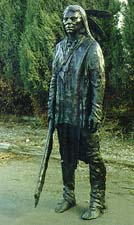Chief Peteetneet facts for kids

Chief Peteetneet was an important leader of a group of Timpanogos Native Americans. His real name was Pah-ti't-ni't, which means "our water place" in the Timpanogos language. He lived near a creek that is now called Peteetneet Creek, located in what is known today as Payson, Utah, in the United States. The creek was named after him, or perhaps he was named after the creek.
Contents
Who Was Chief Peteetneet?
Chief Peteetneet's group of Timpanogos people were semi-nomadic. This means they moved around but also had semi-permanent homes. They lived in houses made from grass, branches, and mud. Their territory included the area around Utah Lake, as well as Sanpete and Sevier counties.
Seasonal Journeys
Chief Peteetneet and another leader, Chief Tabby-To-Kwanah, guided their people on seasonal trips. They traveled through canyons each spring and fall. Peteetneet's daughter, Pomona, also known as Pamamaci (meaning "Water-woman"), married a mountain man named Miles Goodyear.
Meeting the Pioneers
In October 1850, the first Mormon pioneers arrived at Peteetneet Creek. They found Chief Peteetneet and his group of about 200 Timpanogos to be friendly. The pioneers settled on an empty part of the creek, about a mile from Peteetneet's village. It is believed that the pioneer settlement would not have survived the winter without the help and kindness of Chief Peteetneet and his people.
Conflict and Peace
Earlier, in February 1850, Peteetneet's village was attacked by the Mormon militia. This event was part of the Battle at Fort Utah. Chief Peteetneet was not in the village during the attack. However, he later confronted the soldiers at Fort Utah after finding the bodies of several Native Americans. Despite this conflict, he later formed a peaceful relationship with the pioneers.
Trading and Alliances
Chief Peteetneet also had support from Mormon leaders for certain trades. An important leader named George A. Smith gave him special papers. These papers stated that Peteetneet and another leader, Captain Walker, should be treated as friends. It also mentioned that they wished to trade horses, buckskins, and even children. This shows the complex alliances and exchanges that happened between different groups during that time.
Chief Peteetneet's Legacy
Chief Peteetneet passed away on December 23, 1861. His death happened under unclear circumstances in Cedar Valley, Utah. He was buried on a mountainside in Cedar Valley by his people. His wife also passed away shortly after him and was buried in the valley below his grave. This was done so she could join him in the afterlife.
After his death, his relative Ponnewats became the new leader in 1862. Ponnewats' name, Pa-ni-wa-tsi, means "Little Master of Our Water."
Remembering a Leader
Today, a statue of Chief Peteetneet stands in front of the Peteetneet Museum and Cultural Arts Center. This monument was created by local artist Brian Bird in 1993. It helps remember Chief Peteetneet's important role in the history of the area.

